Speed, quality or cost—pick two of the three. We have all heard this phrase and possibly said it to clients ourselves in some form. In sales or engineering organizations this is sometimes referred to as the “Iron Triangle” since these three factors are inextricably tied together. For CPA firm purposes, let’s call this the “Service Triangle.”
This article aims to provide visual models to understand the interplay between the inputs to the Service Triangle and the client’s experiences of our service output in the dimensions of speed, quality and cost. This model will also illustrate how perceived constraints can be turned into leveraged growth with technology and global talent sourcing.
As firm owners and business professionals, we often see a triangle used in sales or engineering as a simplification of the relationship between speed, quality and cost. The common wisdom is that your client can have two of the three, but never all three at once. Even though every client believes they can and should get all three every time!
This framework shows how your clients experience your services—each side translates into how fast, how good and how much your services cost from the client’s perspective. Their total experience is the output of your work represented by each side of the triangle, which looks like this:
Your Grandparent’s Triangle—Service Triangle 1.0
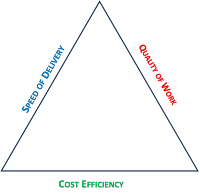
In the traditional concept of the Service Triangle, you have your firm’s positioning in the market based on your balance of the three sides of your clients’ experience of your services: speed, quality and cost. It’s obvious—to everyone but the client—how emphasizing one or two of these factors de-emphasizes the third. Of course, quality is never compromised under our professional standards, so you only have the other two to work with.
Example: Yes, Mr. Client, you can have the report next week, but it’ll cost you.
What can you do?
Each of the output sides of the triangle can be grown or improved based on how you manage and invest in certain inputs. For this discussion, let’s simplify these inputs into three points: Skill, Labor and Process:
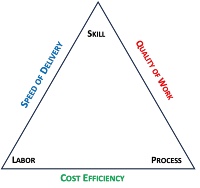
“Skill” includes all the training, experience and knowledge you and your staff bring to an engagement. “Labor” is simply the hours or effort applied. And “Process” is the procedures, templates and work standards that you’ve developed over time.
Growing the Triangle, Growing Your Firm
Growing means investing in one or more inputs with the expectation of improvement in one or more of the corresponding outputs. You invest in each of the inputs, so your client’s experience improves in certain areas.
The more you invest into each input, the higher or better outputs on each side of the client experience. Connecting each corner are the outputs that are directly influenced by the inputs.
Processes are great, as they can improve the consistent output of higher quality work and yield higher cost efficiency by reducing friction and providing focus. However, left in the hands of too little Labor or low-Skilled staff, the Processes can run the show and slow things down. Of course, curses upon the staffer who skips a checklist to increase speed of delivery but ends up having the missed checklist come back to bite them (i.e., the process is there but still fails).
Higher Skill inherently increases quality of work and often leads to an increase in Speed of Delivery (more Skill usually means someone can perform faster). But we know that Skill costs money and this puts a lot of pressure on Cost Efficiency. If you weren’t experiencing how difficult it is to hire quality skilled staff in our profession without spending gobs of money, you might not be reading this article!
The Trifecta—The Service Triangle 2.0
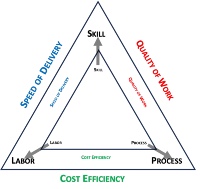
Based on your firm’s positioning, you have the outputs in a particular balance. Ideally, you can grow each input in tandem with the others such that outputs grow as well. But maintaining the right balance is hard. Growing while maintaining that balance is even harder. If the growth is out of balance, even as your ability to perform at a higher level in one of the outputs, you might still be constrained in other areas and the client experience can still suffer. Let’s look at what happens if you don’t grow while maintaining balance.
Uneven or constrained growth
Yes, it would be great if you could grow all input factors in tandem. But that is often not possible.
Each point of input can be leveraged individually, but this has potentially significant risks:
You can add more Labor (expensive, difficult to do and done wrong, has diminishing returns).
You can leverage Skills to improve quality, usually with the by-product of also increasing costs over time as your staff becomes more valuable.
You can leverage Process, but by itself this leads to a lack of professional judgment (i.e., lower quality).
Just like any form of leverage, changes in the inputs can swing the experience outputs both ways. The forces on each corner of the triangle can bring opportunity to improve each side spurring growth and improvement. Constraints or limitations on an input can hamper growth in that area and limit the corresponding sides.
For example, if you’re lacking Process, then you may find it hard to improve the Speed of Delivery and it may be extremely difficult to ensure that your Quality is consistent. Conversely, focusing on Process (e.g. quality control procedures) would allow you to turn out extremely high quality, reviewed and vetted work product, but your Cost Efficiency will suffer, irrespective of whether you hit your deadline or not.
If you have lower Skilled staff, Cost Efficiency may be more upfront, but it will be a challenge to deliver high and consistent Quality of Work (and likely Speed of Delivery will suffer as well).
If you are finding it hard to find Labor, then you’ll probably have to pay more (worse Cost Efficiency) or the Speed of Delivery to the client will be slowed.
The Constrained Service Triangle
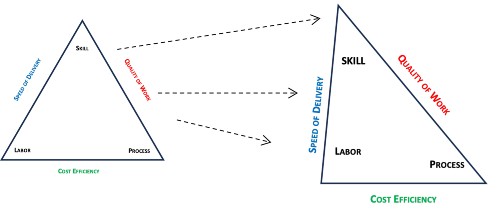
If you are unable to grow the inputs at a consistent pace, the constraints can lead to one or more of the outputs to suffer. And remember, the output is really your client’s experience of your work product.
So, if one of the inputs is out of whack then the growth is hampered, uneven or perhaps just stuck. Even worse, when things are out of balance, every aspect of the client experience erodes simultaneously. How hard is it maintain good Quality when your Speed of Delivery is suffering—i.e., your clients are banging on the door to get their project?
But there is one tactic that leverages technology to move all the levers at once.
By Making Your World Bigger, You Make Your Triangle Bigger–Service Triangle 3.0
More and more, Labor is the one input that is most constrained. Any professional in the business for a while has Process that works for them in terms of their basic technology stack, their models and templates. Skill can be ramped up by teaching the brilliant things you know to your team—if only you had the right team in place or could free up your super stars to continue learning! But with rare exception, finding good and sufficient Labor is like finding a unicorn. Even worse, all too often that unicorn turns out to really be just a donkey with a paper maché horn.
Technology allows secure, always-on communication which makes global labor sourcing possible and effective in a way it never has before. Using all the hard-won lessons from the work from home culture, we can now run highly effective firms with teams ranging from down the hall to around the globe. Tapping into other countries professional populations allows you to obtain highly skilled and abundant labor to support your practice. Releasing the constraints on Labor allows you to simultaneously maintain or improve quality, increase speed and contain costs as you grow your firm.
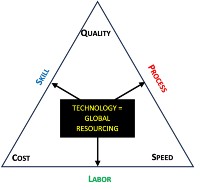
Our firms’ inputs directly shape client experiences. With local labor limited, we turn to global talent via technology to break the constraint. How far can your Service Triangle expand when you unleash the power of global labor?
Ben Towne, CPA/ABV/CFF is owner of Towne Advisory and Assurent Advisors.

